
Once again, another of those odd twists of fate that dog our tracks has conspired to turn up a bike mentioned in an earlier presentation, so we find ourselves obliged to follow up the feature to rest its wandering spirit. This story however, seems to start with a bike that never was...
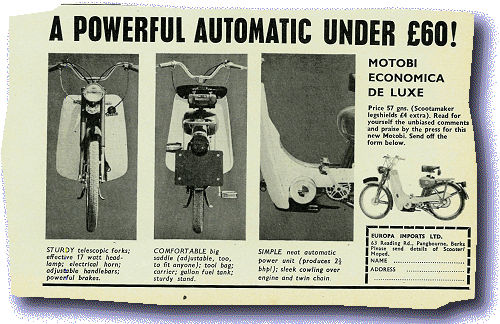
September 1965 found the pages of Power & Pedal magazine presenting a feature on a new Motobi 'Economica' moped. The timing of this promotional announcement was probably planned by Europa Imports concessionaires shortly before an intended formal introduction of the machine at that year's Earls Court Show in November.
Being an automatic commuter model, the bike was unflatteringly described as "not a particularly sleek looking, open-frame machine" of 40mm bore × 39mm stroke, for 48cc, and producing 2.5bhp @ 6,000rpm. Mounting telescopic forks, the rigid-rear frame ran on 2.00 × 18 wheels, with 6 Volt × 17 Watt lighting set, plastic one-piece chainguard/frame trim, and moulded leg shield set (optional extra, £4).
The report particularly praised the "usable power" of the horizontally arranged Benelli engine, describing "nearly 40mph top speed", and "superb road holding".
The Economica sounded a most excellent little machine and, being "jolly good value at 57 guineas", was predicted as "certainly going to be big seller" - but this was seemingly not to be, since the model failed to achieve any listing entry, and was never heard of again.
Beyond the text description, the accompanying picture didn't really reveal much since plastic coverings concealed most of the engine detail, so apart from the distinctive and quirky 'bubble' petrol tank below the saddle, the bike remained largely a mystery.
Following on from our earlier Motobi article Not an Egg in April 2010, and quoting a passage from the text; "Glass's Index shows a 'Mini 16' (whatever that may be?), added to Europa Imports listings for 1966".
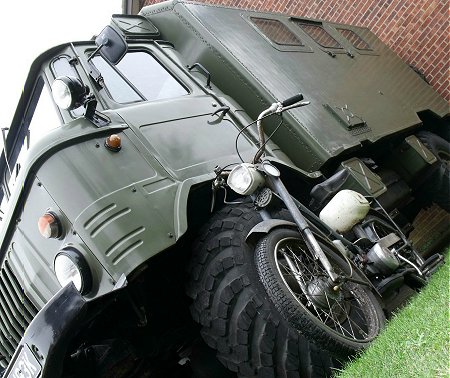
At that time the Mini 16 was left as no more than a question, since beyond the Glass's entry, we'd not found any further references among the library files, but would now appear to have fallen upon an example that seems to be not only this elusive machine, but also seems to be a derivative of the lost Economica!
Looking round our odd automatic Motobi, the distinctive hooped rear forks and bubble tank unmistakably match the Economica, but this machine wears 2.50 × 16 wheels instead, hence the Mini 16 conclusion. The frame however appears unchanged, since the smaller wheels seem to leave a larger gap within the mudguards. Apart from a white finished petrol tank, and now mounting a light plastic headlamp in place of the pressed metal shell of the Economica, everything else appears much the same.
It's presumed the factory may have shortened the centre stand legs to maintain a more acceptable parking clearance, and our weathered example has lost its plastic chain guard and trim to an improvised alloy chain guard and chequer pattern footplates to dress the frame.
Now revealed, the blank-sided fin pattern of the alloy cylinder head and iron barrel are somewhat reminiscent of the Moto-Guzzi Motoleggera, while apart from the horizontal layout, the rest of the motor much resembles the general appearance of the period Benelli vertical cylinder types.
It's most unusual to see machines with the main drive and pedal chains both running on the same side. The only other examples that readily come to mind being the Raleigh RM1 and RM2 models (which transmission runs on the right by means of a crossover shaft for the main drive), and the Derbi Antorcha.
Like the Derbi, our Motobi runs both its transmission chains out on the left!
Any cyclist readers will probably immediately appreciate the implications of this 'wrong sided' arrangement, as the pedal freewheel is rather likely to be a special left-hand thread. Replacement of such a unique component would probably present some most considerable difficulty.
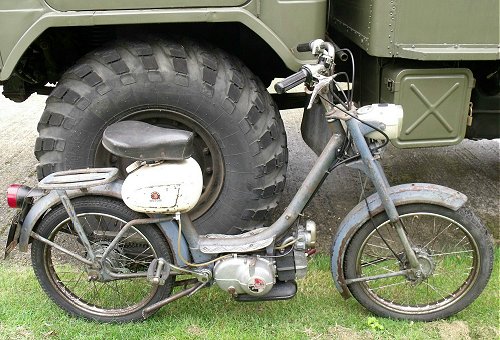
For starting, the budget petrol tap lever rotates in quarters, 3 o'clock off, 6 o'clock on, 9 o'clock off again. We did check, and there's definitely no reserve.
Carburetion is by a conventional and familiar Dell'orto SH12-14, so click down the choke, which will snap off automatically when the throttle is opened full.
Just turning the pedals fails to spin the motor, so on typical unit automatics we'd normally be looking for some clutch lock lever under the left handlebar cluster, but there doesn't appear to be one?
There is however, what appears to be a gear-change twistgrip, with a cable running down to the motor! What's going on here? We check the left hand lever - no, it's definitely the back brake, not a clutch. The brake lever turns as the grip rotates, which then seems to load-up the mystery cable without any feeling of engaging a gear. Holding the grip round, we try the pedals, and now the engine turns!
It looks as if Benelli decided to use a gear-change twistgrip to operate the clutch-lock starting function, instead of a second lever! You do, though, need to twist the grip around very hard to prevent the plates slipping against compression, and this proves more effectively operated by pulling round the brake lever instead. Probably not quite how the maker intended, but saves straining your wrist, so, another neat idea that doesn't really work - no surprise we've never seen it previously, on any machine, before or since.
A couple of spins and the motor fires up, and sounding immediately responsive, so open up the throttle to release the choke - and it's still responsive, surprisingly ready and willing almost straight away. OK then, away we go...
The automatic single-speed motor pulls strongly and steadily right from take-off, up to comfortable cruising just under 30mph. We sit at this settled pace for a while, to work some heat into the engine, which seems contented enough coasting along beneath the urban limit...
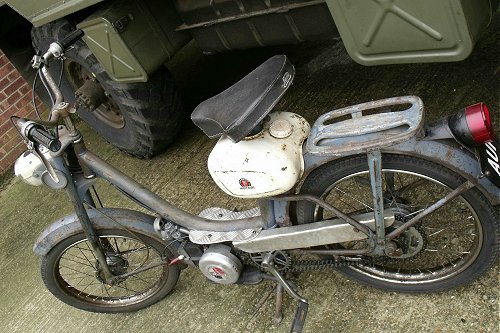
Now, bearing in mind this is an innocuous automatic commuter moped around the late 1960s, so from a sub-30 cruising speed, you might be expecting to open the throttle, and slowly limp your way up to maybe a fraction over 30 if you're lucky, then that'd be your lot - but there's a surprise punch! Open up the throttle more, and there's still loads of twist left in the grip!
The Benelli engine eagerly responds to power the bike up to a paced 37mph on the flat with rider crouched. Still keen to get on and rev, the motor urged onwards up to a 40mph paced maximum on the downhill run, then charged enthusiastically at the incline on the other side, to blaze the crest at a most creditable 27mph.
For a single-speed auto moped, Mini 16 demonstrated a pretty impressive performance throughout the test. The gutsy and willing 2.5bhp Benelli motor is what allows this little bike to punch well above its weight and, to put this rating into context for the time, consider Motobécane's AV89 based Sport Spéciale 50 model was given at 2.67bhp, and a top machine of the day, so Motobi gave a most remarkable showing for a basic commuter moped.
The French 60mph Huret might seem a somewhat unexpected instrument to find on an Italian moped, but maybe not if the machine was marketed without a speedometer, which was then added as an accessory after importation. Since continental machines normally indicate kilometres, this would seem fairly likely for a British market bike.
Speedo indications compared reasonably to the pace bike on this occasion - seemingly one of Huret's better days!
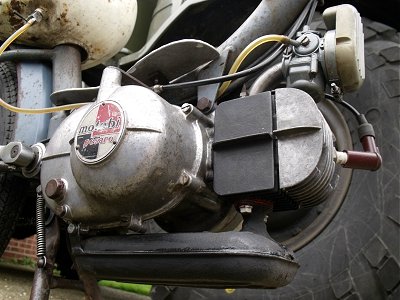
Despite a rigid rear frame, the 2.50 × 16 wheels worked well for the handling and Mini 16 could be flicked through speed-cornering with a high level of confidence.
The small wheels also contribute to produce quite a compact chassis, with a short 42½-inch wheelbase and total length of just 66 inches. The saddle height will set down to a lowly 30 inches, so this is quite a physically small moped compared to many of its period contemporaries.
The padded, sprung frame of the Giuliari single saddle gave a fairly comfortable seat.
A five-way handlebar switch conventionally operates horn and engine cut-out, but while the lighting switch starts from central-off, the expected dip position only engages a rather dull 'festoon' sidelight bulb. The headlight 'beam' produced far brighter illumination than might have been expected from its 15 Watt lamp, but was not reflected by the dim glow from the large red lens of the circular CEV 3 Watt rear unit.
The only observable criticisms certainly being difficulty in twisting round the left grip hard enough to engage the starting clutch, and reference to rather noticeable mechanical running noise, which seemed to emanate from the transmission (left) side, though would probably have been far less apparent on a machine retaining its original plastic shielding set.
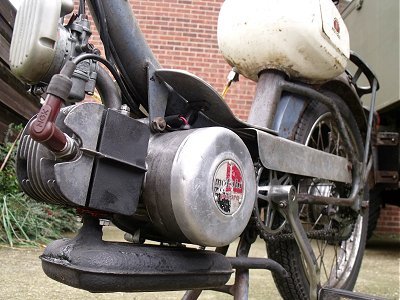
Probably overlooked for its odd-looking petrol tank and basic step-through arrangement, Mini 16 was actually a great, all-round, commuter moped. Its strong acceleration proved really good for keeping up with traffic pace in an urban transport role, and was completely un-fazed by hills, which it galloped up at a most determined pace.
Probably cost led, since smaller size = less materials, a trend toward smaller wheels was gathering pace into the early 1960s. From the generally more common 26-inch or 23-inch (19-inch rim) sizes of the 1950s, the next decade certainly found progressively smaller wheel sizes appearing on mopeds. Mobylette AV89 models introduced 18-inch rim sizes, and 12-inch rims on the Raleigh Wisp and Clark Scamp. Italian 17-inch & 16-inch rims were relatively new to mopeds at the time of the Motobi Mini 16, so Benelli were probably among the earliest of manufacturers adapting the size onto the Economica.
Another variation of the Economica/Mini 16 theme was released onto the market in 1966, titled as the 'Gentleman' model and sold on the continent under the Benelli brand.
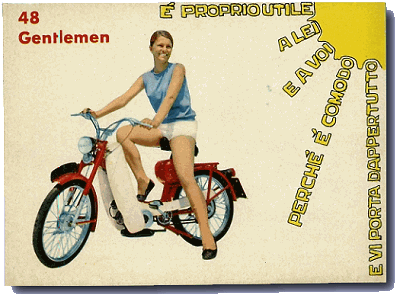
Europa Imports remained with the same 'under 100' line-up of 'Automatic', Mini 16, 48 Moped, 48 Sport, Texan, Fabulous 48, and 98 Scooter, until UK imports stopped in September 1968, after its Motobi branded models failed to achieve any competitive levels of sales.
The Motobi brand was revived in 2010, by Austrian company Michael Leeb Trading GmbH in partnership with Demharter GmbH, selling a range of 50cc scooters, and providing sponsorship for the JiR motor cycle racing team in the Moto2 competition class.
Next - We make a lot of efforts in tracking down and testing the most obscure machines for features, which is all very well, as long as examples survive - but what to do if nothing exists? We can never test a bike that's actually extinct, but another form of presentation may still be possible. Way back in 2004, a research series was started on several machines, all of which were firmly believed to be extinct - no traceable examples survive.
Quite a bit of work was done, but the series never progressed to completion due to political issues within the dismal old autocycle club (a situation that sadly still continues today).
These research notes turned up again recently as a number of old files, and it might seem a pity to simply mothball the work again, so we thought we might try to complete one from time to time as a bit of a change.
The old research series was titled "Legions of the Lost", and the first analysis presents a final solution to a moped that never was.
[Text and photos © 2012 M Daniels. Period documents from IceniCAM Information Service.]
The Mini 16 feature bike came to us amongst a job lot of ex-number-plate-trade 'junker bikes', and, when the van was unloaded into the workshops, we didn't know quite what it was at the time. The Motobi isn't exactly a common machine; the engine was seized; it was dirty, dusty and rusty, and we hadn't actually seen one before.
The workshop routinely unstuck the motor, fitted new piston rings, repaired the exhaust, and sorted out the cycle parts. That element was easy, up and running again in no time at all, but its previous life as a registration retention vehicle cultivated a number of difficulties when trying to sort out the documentation.
Somewhere along the long progression of various 'cherished' number transfers, its identity had mysteriously mutated from Motobi to Motobécane! Perhaps the DVLA computer failed to recognise Motobi, and switched to the nearest similar name at some time? Who knows?
The indicated frame number was correct, and the V5 suggested a matching engine number, but adding to the complications of correcting the documentation - Motobi didn't actually stamp any engine numbers!
The whole muddle sat in the bureaucratic tubes of indecision for literally months, with no-one in officialdom willing or able to make any judgement on what to do about correcting the details. The eternal trail of number transfers exceeded traceable records back to its original registration, so if in doubt, the answer seems to be - do nothing!
After floating in limbo for a couple of months it took a right rocket to prompt any action, finally a VOSA inspection to satisfy them the Motobi really was a Motobi and tick the appropriate boxes, then re-issue the documentation with the obvious adjustments just to get it out of the holding tray.

After all that hassle, it just seemed a pointless step too far to try and correct the fact that the bike ended up with a 1972 K-registration number on a 1966-1968 bike!
Finally the bike could be taxed & tested, then went on road test and photoshoot in September 2010, which gave a completed turn-round time on the feature of around 18 months. Mini 16 went really well for the test, and with the whole moped being smaller than the wheels of Chris Day's Russian ГАЗ truck in the background, the pictures seemed to emphasize the subject of the article.
Once our mini-feature was completed, there wasn't really much further reason to retain the bike, so off it went into the big wide world to make way for something else. At least the exercise returned the machine to use, and it's been regularly seen around the local rally circuit since.
We don't account workshop time and parts cost in the article production since these are recovered when the bike is sold on, so production of the Mini 16 article involved only negligible expense.
We just happened to receive a small sponsorship donation from Graham McLean out in Oz about the time the article was completed, so the credit just got tacked straight on.